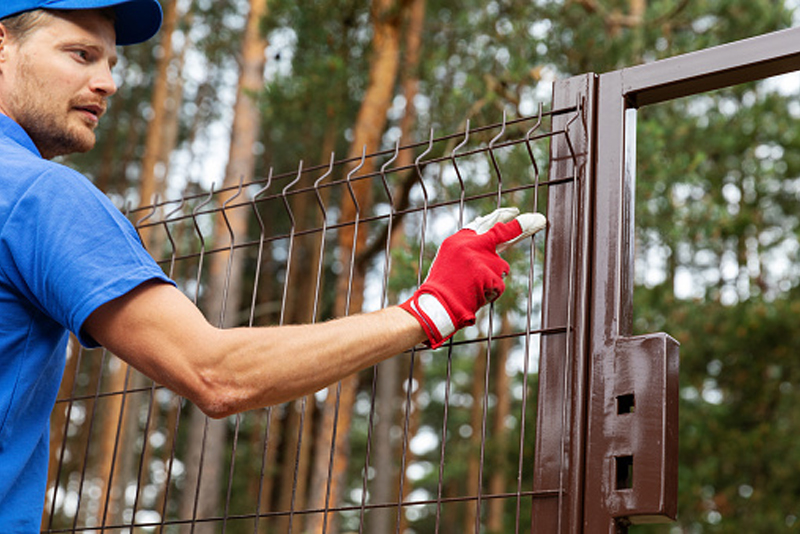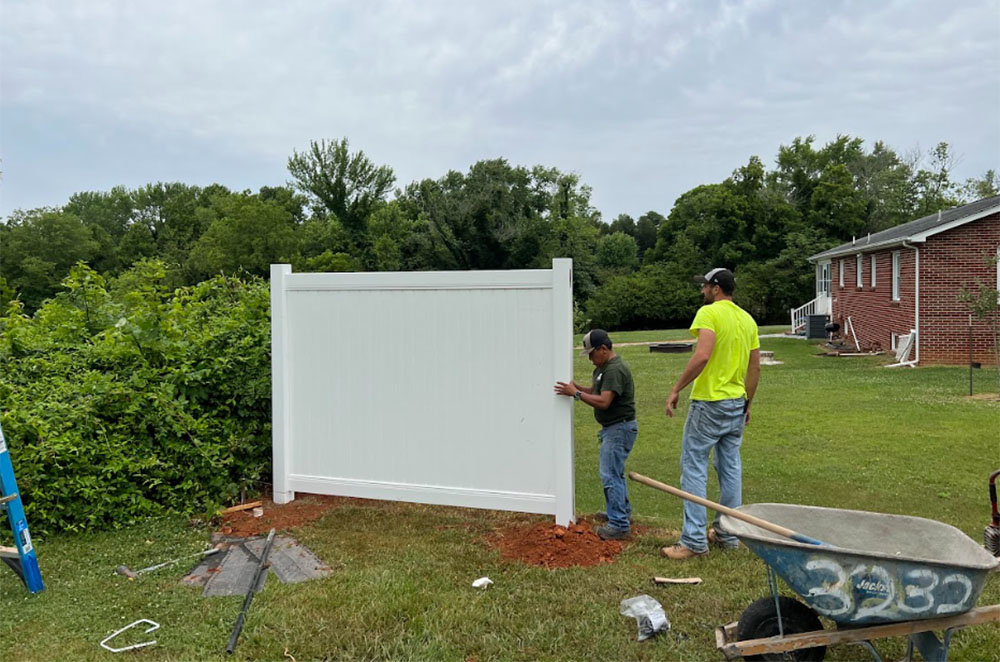Popular Trends in Outdoor Spaces from a Professional Deck Builder
Popular Trends in Outdoor Spaces from a Professional Deck Builder
Blog Article
Just How to Recognize Common Problems That Need Immediate Fence Fixing
When it comes to preserving your fencing, it is important to detect issues prior to they come to be bigger problems. Consistently inspecting for signs of decomposing wood, leaning panels, or corrosion can conserve you time and cash in the future. You could not recognize how weather and bugs can compromise your fence's honesty. Let's explore the common indicators that show your fencing needs prompt focus, so you can maintain your residential or commercial property safe and looking its finest.
Indications of Rotting Timber in Wooden Fences
Have you observed your wooden fencing looking a bit worse for wear? If so, it may be time to inspect for signs of decaying timber. Check out the base of the posts and panels for soft spots. That's a clear indication of rot if you press on the timber and it feels squishy or collapses. Next off, seek staining or dark areas on the timber-- these often signal moisture damage. Focus on any peeling paint or coating, as this can reveal the timber to more degeneration. Furthermore, a pungent, mildewy scent can indicate fungal development. Don't neglect to check links and joints; if they hang or breaking down, the timber underneath is most likely endangered. By capturing these signs early, you can avoid more comprehensive damages and keep your fence standing solid. Routine upkeep is essential to expanding the life of your wooden fence.
Leaning or Tilting Fencing Panels
It's important to understand what created it if you've observed your fencing panels tilting or leaning. This concern might indicate underlying architectural damages that requires your attention. Allow's check out the common causes and the fixing alternatives available to get your fence back fit.

Sources Of Leaning Panels
It's often an indication of underlying problems that require resolving when you discover your fence panels leaning or tilting. One usual reason is poor drainage; too much water can wear down the dirt around the fence articles, compromising their support. An additional offender can be solid winds or storms that press against the panels, specifically if they're not properly secured. In addition, the natural settling of soil in time can cause articles to change, resulting in a tilt. Pests, like termites, can endanger the stability of wood panels, causing them to lean also. Finally, inadequate installment practices may lead to panels not being securely set, leaving them susceptible to leaning under pressure. Address these issues quickly to preserve your fencing's stability.
Indicators of Architectural Damage
Noticing turning or leaning fencing panels can be disconcerting, as these concerns often show architectural damages that requires instant attention. When your fence begins to lean, it might indicate that the messages are moving or that the soil around them has eroded. Pay very close attention to voids in between panels or blog posts, as these can additionally recommend instability. deck builder. Additionally, check for cracks or splintering in the timber, which can weaken the overall framework. It can jeopardize the stability of the fencing if you notice corrosion or deterioration on steel parts. Bear in mind, overlooking these indications can result in a lot more serious damage down the line, so it's necessary to assess the scenario without delay and do something about it before it worsens
Repair Options Available

Corrosion and Rust in Metal Fences
If you possess a metal fencing, you may notice corrosion and rust sneaking in gradually, especially if it's revealed to moisture. These concerns not only affect the appearance of your fencing yet can additionally compromise its structural stability. To determine corrosion, search for reddish-brown places or patches, which suggest the steel is oxidizing. Corrosion can spread rapidly if left untreated, leading and deteriorating the fencing to pricey repairs.To deal with rust and deterioration, you should clean the affected locations with a cable brush and use a rust-inhibiting primer. As soon as the primer dries out, take into consideration repainting the fencing with a weather-resistant paint to protect it additionally. Normal maintenance, such as examining for indicators of rust and retouching paint as required, will aid extend your fence's life expectancy. Addressing these problems without delay guarantees your steel fence stays strong and aesthetically appealing for several years ahead.
Fractures and Divides in Vinyl Secure Fencing

Reasons For Plastic Damage
Vinyl secure fencing is popular for its toughness, yet it can still experience from cracks and splits because of different factors. One major cause is severe temperature level changes. It can deteriorate the product over time when plastic broadens in the warmth and agreements in the cold. Furthermore, direct exposure to extreme sunshine can bring about UV destruction, making the vinyl weak. Physical impacts, like heavy branches or unintentional accidents, can also develop fractures. Poor installment or using low-quality products can worsen these issues. Additionally, age plays a role; older vinyl fencing is a lot more susceptible to damage. Regular assessments can aid you identify these elements prior to they lead to significant issues. Take aggressive actions to assure your fence stays strong and undamaged.
Fixing Cracks Effectively
Although fractures and divides in your plastic fencing can be concerning, addressing them quickly can avoid more damages and maintain the fencing's appearance. First, examine the dimension of the crack. For small splits, a plastic repair service set typically consists of glue that can bond the edges, offering a seamless solution. Clean the location completely prior to applying the sticky, ensuring it adheres appropriately. For bigger divides, you may require to use a plastic spot. Cut the patch to dimension, apply adhesive around the edges, and press it firmly onto the split. Enable it to treat based on the producer's instructions. Routine maintenance and fast repair services can expand your fencing's life expectancy, keeping it looking terrific for several years to come.
Loose or Missing Out On Fencing Articles
Loosened or missing fencing articles can threaten the security of your entire fencing structure. If you observe any posts leaning or tottering, it's vital to attend to the issue immediately. Look for any kind of signs of activity, as this can bring about more damage over time. You can conveniently assess the issue by offering each message a gentle shake-- if it really feels unsteady, it's time to take action.For missing out on posts, you'll need to change them immediately to keep your fence's stability. When you set up brand-new articles, see to it they're firmly anchored in the ground with concrete or crushed rock for added stability. If a post is loosened, tighten it by adding extra assistance or driving it deeper into the ground.Ignoring these problems can cause larger issues, like voids in your fencing or perhaps total collapse. So, keep an eye on your posts and remain positive about repairs!
Damage From Weather Condition and Natural Components
Climate and natural elements can ruin your fencing, causing numerous kinds of damage that require timely focus. Heavy rain can create timber to rot, making it unsteady and click here weak. Snow accumulation could flex or damage panels, while strong winds can uproot fencing messages or trigger areas to lean.If you notice fractures or splintering in wood fences, it signifies drying due to extreme sunlight direct exposure. Metal fencings can corrosion if safety finishes wear off, particularly in moist or coastal areas.Inspect your fencing on a regular basis after tornados or extreme weather to capture any kind of damage early. Resolving these concerns swiftly can save you from pricey fixings down the line. Do not wait until a little problem transforms right into a major one; stay positive and keep your surround top shape to maintain both functionality and visual allure.
Pest Infestation and Termite Damages
When you observe indicators of pest invasion or termite damages, it's vital to act promptly to avoid additional damage. Look for mud tubes along your fence or hollow-sounding timber, as these suggest termites go to job. You could likewise see little openings or frass, which is termite droppings appearing like sawdust. If you spot any of these indications, it's time to assess the damage.Don' t wait until it's far too late; insects can jeopardize your fencing's stability. Check the surrounding location for beetles or ants, as they might be adding to the problem. If you think an invasion, think about contacting a pest control specialist to deal with the issue.repairing and validate or replacing afflicted areas of your fence immediately not only recovers its toughness but likewise avoids pests from spreading out even more. Keep cautious to keep your building pest-free and safe and secure.
Regularly Asked Questions
How Often Should I Examine My Fence for Damage?
You should examine your fence at the very least twice a year, ideally throughout springtime and autumn. Regular checks assist you find damages early, conserving you time and money on fixings while preserving your residential or commercial property's look and safety.
Can I Repair a Fence Myself or Hire a Specialist?
If you have the right devices and abilities, you can certainly fix a fence yourself. Nonetheless, working with an expert assurances top quality job and conserves you time, specifically for complicated repair services or extensive damage.
What Tools Are Needed for Basic Fencing Fixings?
For fundamental fence fixings, you'll need tools like a hammer, screwdriver, pliers, a saw, a degree, and determining tape. deck builder. Relying on the fixing, you could additionally call for nails, screws, or replacement boards
Just How Much Does Fence Fixing Typically Expense?
Fencing repair work costs differ extensively, but you can anticipate to pay between $200 and $1,500 relying on products, labor, and level of damages. It's smart to get several quotes for the finest deal.
When Is the Ideal Season for Fencing Repairs?
The most effective time for fence repairs is during light weather condition, usually in spring or early loss. You'll avoid severe temperature levels, making it less complicated to function and guaranteeing the materials set properly for lasting sturdiness (deck builder). Noticing tilting or leaning fencing panels can be worrying, as these concerns often show architectural damages that requires prompt focus. Loose or absent fence articles can threaten the security of your entire fencing structure. Snow buildup might flex or break panels, while solid winds can root out fencing posts or cause sections to lean.If you observe fractures or splintering in wooden fences, it's an indicator of drying out due to intense sunlight direct exposure. Metal fencings can rust if safety layers put on off, particularly in coastal or damp areas.Inspect your fencing on a regular basis after tornados or severe weather to catch any kind of damages early. Fencing fixing costs differ extensively, yet you can anticipate to pay between $200 and $1,500 depending on materials, labor, and extent of damages
Report this page